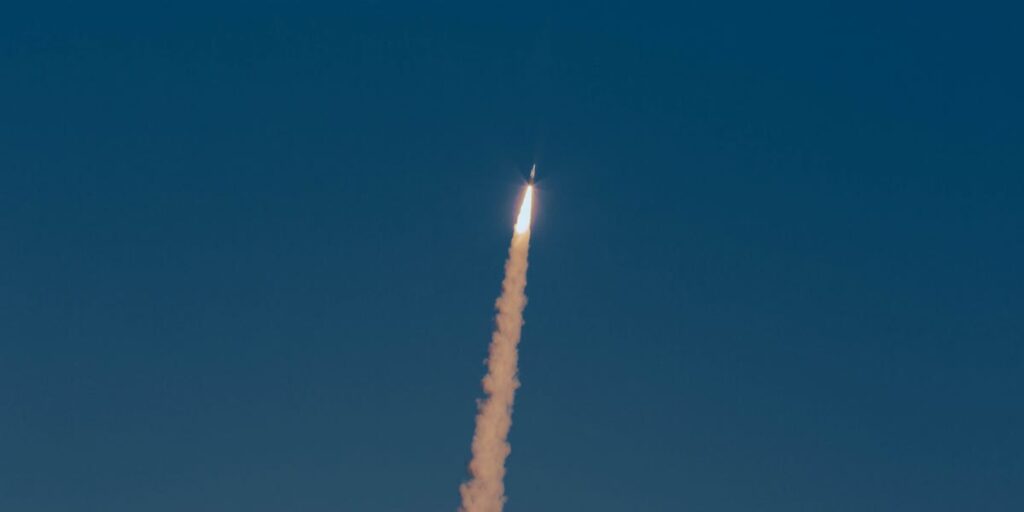The US Army is sending its powerful new ground-fired missile system to Japan during joint exercises this month.
The Mid-Range Capability, or Typhon, fires different missiles that can strike targets on land or at sea. The truck-mounted Typhoon launcher carries missiles in vertical launch tubes that have the extended ranges needed to target fleets in the Pacific and even sites on the Chinese mainland, repeatedly drawing anger from China.
During Exercise Resolute Dragon this month, an annual training between the US Marine Corps and Japan Self-Defense Force, the Army’s 3rd Multi-Domain Task Force “will deploy the Typhon missile system to Marine Corps Air Station Iwakuni” located south of Hiroshima, according to an Army statement obtained by Business Insider.
Typhon’s deployment is focused on promoting training and interoperability with Japanese systems and capabilities in a realistic environment, the service added. The Typhon is capable of firing cruise missiles with ranges many times that of the Army’s ATACMS tactical missile — capabilities similar to US warships — and can be staged on secluded bases in the Pacific.
The announcement of Typhon’s involvement in the upcoming Resolute Dragon sparked new pushback from China. “China always opposes the United States deploying the Typhon Mid-Range Capability missile system in Asian countries,” Chinese foreign ministry spokesperson Guo Jiakun said on Friday.
Russia, too, condemned the deployment. On Friday, Russian foreign ministry spokesperson Maria Zakharova called Typhon’s move to Japan “another destabilizing step as part of Washington’s course towards ramping up the potential of ground-based shorter and intermediate-range missiles.”
She added that Typhon being in Japan “in regions near Russia poses a direct strategic threat to Russia.”
The US has maintained that the deployments of Typhon in the Indo-Pacific with its allies and partners in the region is to promote interoperability, advance forward-deployed long-range precision fires, and ensure a free, open Indo-Pacific.
News of Typhon deploying to Japan also comes just days before China’s planned massive military parade on September 3, during which it will potentially reveal new weapons systems and capabilities.
Typhon can carry the Standard Missile-6 and the Tomahawk Land Attack Missile. The SM-6 has an estimated range of up to 230 miles, potentially extending to 290 miles for certain variants.
Tomahawks, long-range, subsonic cruise missiles, have estimated ranges from 1,000 to 1,550 miles depending on variants and are routinely carried by US warships and attack submarines. Both of these systems give the Army longer reach and more dispersal to attack the multitude of maritime and land targets that China has amassed in the Pacific region.
The Army has been exploring how best to employ the Typhon since its development, which followed the 2019 US withdrawal from the 1987 Intermediate-Range Nuclear Forces Treaty over concerns about Russian violation. The treaty banned ground-launched ballistic and cruise missiles with ranges of 500 to 5,000 kilometers.
The withdrawal was overseen by the first Trump administration and driven by Moscow’s SSC-8/9M729 missile, opening the door to the development of previously banned weapons.
The system most recently completed a live-fire exercise in Australia during the annual Talisman Sabre exercise in July, during which the 3rd Multi-Domain Task Force fired an SM-6 and sank an unspecified maritime target.
It was the first time the land-based Typhon had been fired west of the international date line, which splits the Pacific Ocean, and was a significant step for the Army in deploying and operating land-based maritime strike capabilities, the service said at the time.
Prior to that, Typhon had been deployed in the Philippines during a joint exercise last year, quickly drawing China’s frustration. In September 2024, Lin Jian, a spokesperson for China’s foreign military, called the deployment “a move to turn back the wheel of history,” adding that “it gravely threatens regional countries’ security, incites geopolitical confrontation, and has aroused high vigilance and concerns of countries in the region.”
The Philippines has also noted that Typhon’s presence has angered China. In August of last year, Filipino Foreign Secretary Enrique Manalo said that his Chinese counterpart, Wang Yi, had expressed concerns that the weapon could destabilize the security and relations of the region and that when they discussed it, China “made it very dramatic.” China has warned Manila against igniting an arms race.
The 3rd Multi-Domain Task Force has also been tinkering with Typhon in the field. During its deployment in the Philippines, soldier input and feedback led to “multiple design changes” in the system.
Read the full article here


